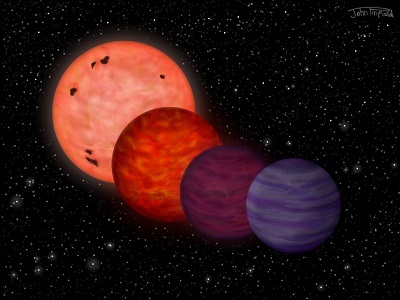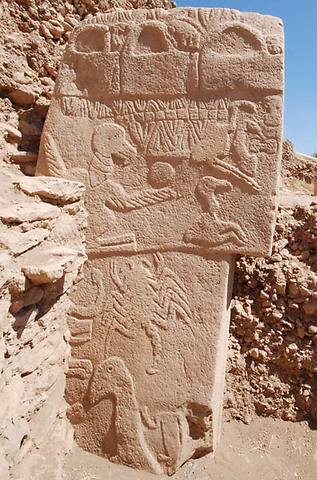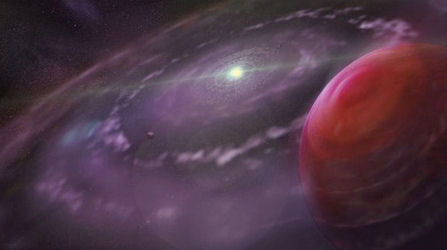
Andy Lloyd's Dark Star Blog

Blog 05 (August 2013)
Jupiter-like exoplanet challenges planetary formation theory
When I first started writing about Dark Stars back in 1999, I had little realisation that they might turn out to be pink! At that time, knowledge about brown dwarfs was in its infancy and there had not yet been any discoveries of ultra low-mass failed stars. The larger versions, of masses between twenty and eighty times that of our own Jupiter, were red - despite the tentative moniker 'brown dwarf'. But as time has gone on, we have started to learn a lot more about the objects on the lower end of the spectrum. These sub-brown dwarfs are now being imaged, and their colours are turning out to be more magenta than red. In the case of GJ 504b, which orbits its parent star that's around 57 light years away, the colour is positively pink! Is this, then, the true colour of our own as-yet-undiscovered Dark Star?

Well, I would say its about the right size, weighing in at 4 times the mass of Jupiter. Astronomers studying the sub-brown dwarf GJ 504b think its pinkish colour might be attributable to a lack of cloud cover. It's also a lot younger than any Dark Star we might have circling at some distance from our Sun. Nevertheless, this might still be what we should expect of a "Nemesis"-style object. Less returning wrathful god than stylish succubus, n'est-ce pas?
This new Pink Lady, which fittingly lies in the constellation Virgo, is challenging planet-formation theories, too. Although it is four times more massive than Jupiter, its orbit around its parent star is further out than our own planet Neptune. Which begs the question of how it formed, given that the accretion disk at that distance should be insufficient to the task of building such a colossal world. Did it migrate out to that distance? Or was another mechanism involved in its creation? Either way, this discovery opens the door slightly wider to the potential for a similar world to have formed in the outer solar system.
Andy Lloyd, 7th August 2013
Reference:
B. Parnell "Super-SVELTE BLUSH-PINK planet goes too far with star" 6 August 2013, with thanks to Lee
An Ancient Warning?
The ancient site of Göbekli Tepe in Turkey has set back the clock of ancient civilisations by thousands of years. It is thought to date to about 10,000BCE. Much of it remains underground, still, and is in the process of being slowly unearthed. As that process continues, its becoming increasingly likely that the key to understanding this most ancient of sites lies in the sky. However, deciphering any archaeo-astronomical clues is made tricky by questions about the relative chronologies of various parts of the site.
A recent paper written by archaeo-astronomer Giulio Magli speculates that the reappearance of the star Sirius, as the skies shifted over millennia, was the driving force behind the construction of this remarkable ancient observatory (1).
"I am thus proposing here the possibility that the structures of Göbekli Tepe were constructed to celebrate, and then follow in the course of the centuries, the appearance of a brilliant “guest” star in the sky: Sirius. ...Getting more insight in the symbolic world of the builders would certainly be of help; many of the animals [depicted on the stones] are tempting as representation of constellations, and – curiously enough – one of the most elaborated stelae present an upper register with three “bags” which are pretty similar to the three “houses of the sky” occurring in the much (very much!) later Babylonian “kudurru” traditions." (2)
You can see the "three bags" he mentions in the image of Pillar 43 (3).

Is the Turkish site a very ancient precursor to the civilisations that emerged much later in the Levant? This seems to be the implication of the shared symbolism employed here. Things take a more intriguing turn a little later into his paper. Right at the end, he makes a few speculative points, including this rather interesting observation:
"On the pillar 43 of enclosure D a suggestive, unique scene is represented: a sort of vulture with human traits delicately “rises up” with a wing what seems to be a sphere, or a disk. May this be a representation of the Heliacal rising of the newly born star we today call Sirius...?" (2)
This strange depiction seems to me to also share a passing similarity to the Winged Disk symbolism later employed by the Mesopotamians and the Egyptians alike. The broader astronomical context seems befitting, too.
If this really is a remarkably early precursor to the Winged Disk, then what does that tell us? Firstly, that this is unlikely to depict the star Sirius. Secondly, that this entire site is trying to tell us something important about a very, very ancient event in the sky. Is it a warning to later generations, perhaps? Putting my Sitchinite hat on, I would point out that the timing of the construction of Göbekli Tepe may provide a further clue. Zecharia Sitchin argued that the Biblical Flood took place around 13,000 years ago, an event similarly described at length by the Sumerians and Babylonians:
"Our endeavour to unravel the puzzle of the Deluge, then, focuses on Earth's climatic changes, and in particular the abrupt collapse of the ice age some 13,000 years ago." (4)
This event, he speculated, coincided with the transit of Nibiru through the solar system, triggering monumental Earth changes (4). For a number of reasons, the story of survival after this Deluge is connected with Mount Ararat, which is also in Turkey. I wonder if this is mere coincidence?
Consider the following possibility: About 13,000 years ago 'Nibiru' did indeed invoke a massive cataclysm. Whatever the mechanism, the Ice Age was abruptly brought to a halt by a global tsunami which wiped out low-lying human settlements all over the world. Water levels rose permanently, and the survivors shifted ground away from the submerged coastal areas and river valleys that they had lived in for generations. This traumatic period was marked by a desperate fight for survival and renewal which led in turn to an oral tradition that lasted through to Biblical times, becoming the legend of Noah - as well as similar myths all over the globe.
To supplement the warnings in these oral traditions, the ancients constructed complex stone sites to depict the arrival of Nibiru, and warn of what might happen next! This, I suggest, is what Göbekli Tepe was all about. This strange disk on pillar 43 held by an anthropomorphic vulture may be the earliest known depiction of the returning planet Nibiru, shortly to be followed by the cataclysm which almost destroyed the ancient world.
Andy Lloyd, 7th August 2013
References:
1) "Astronomical Alignments at Gobekli Tepe?" 1 August 2013, with thanks to Lee
2) Giulio Magli "Sirius and the project of the megalithic enclosures at Gobekli Tepe"
3) S. Clouth "Gbekli Tepe Yields Groundbreaking Insights" 13 August 2012
4) Z. Sitchin "The Twelfth Planet" pp401-4 Avon 1976
Out of the Blue, The Huffington Post highlights Tyche
At the end of July, The Huffington Post (1) updated a news item that The Independent had covered way back in February 2011 (2). The earlier article from the British newspaper had reported that astrophysicists John Matese and Daniel Whitmire were hoping that data from WISE might demonstrate the existence of the a massive planet among the comets that they have provisionally named Tyche. Given the two year lapse, one presumes that WISE has not provided the data that this team of academics from Louisiana had hoped for.

It's a puzzle to me, therefore, why The Huffington Post updated their article (26th July 2013) in the way that they did. Their allusion to the future crunching of data that will be made available in April makes no sense, given that that relates to events from back in 2011:
"Despite what the scientists believe they will find in the data (which will be released in April and was collected by NASA Wise space telescope), there is at least one flaw in their theory. Theoretically, a planet of Tyche's size should seriously disturb comets in the inner Oort Cloud, but that effect is yet to have been observed..." (1)
Are they privy to information of an impending discovery, and are paving the way with this hastily regurgitated piece? Or is this just cut-and-paste journalism at work during 'silly season'?
Regardless, the following quote from the original article in The Independent is worth repeating, as it indicates some of the hurdles that the Dark Star concept needs to overcome:
"Professors Matese and Whitmire first proposed the existence of Tyche to explain why many of these long-period comets were coming from the wrong direction. In their latest paper, published in the February issue of Icarus, the international journal of solar system studies, they report that more than 20 per cent too many of the long-period comets observed since 1898 arrive from a band circling the sky at a higher angle than predicted by the galactic-tide theory.
"No other proposal has been put forward to explain this anomaly since it was first suggested 12 years ago. But the Tyche hypothesis does have one flaw. Conventional theory holds that the gas giant should also dislodge comets from the inner Oort Cloud, but these have not been observed.
"Professor Matese suggests this may be because these comets have already been tugged out of their orbits and, after several passes through the inner solar system, have faded to the point that they are much harder to detect.
"So if it is real, Tyche may not only be disrupting the orbits of comets, it may also overturn an established scientific theory." (2)
That 'hurdle' may also be a fundamentally important piece of evidence, in that it would also follow on from the idea of a Dark Star sweeping out the inner layers of comets during perihelion transits. You can read this either way, to be honest.
Andy Lloyd, 28th July 2013
1) D. Praetorius "Tyche, Giant Hidden Planet, May Exist In Our Solar System" 26 July 2013
2) P. Rodgers "Up telescope! Search begins for giant new planet: Tyche may be bigger than Jupiter and orbit at the outer edge of the solar system" 13 February 2011
Author Michael Luckman on an Impending Planet X Event
Hi Andy:
You were kind enough to review my book, "Alien Rock" some years ago. I was a friend of Zecharia Sitchin and an associate of the late Tom Van Flandern, the former Chief Astronomer for the U.S. Naval Observatory in Washington, D.C. who told Robert Harrington the coordinates for Planet X. Harrington found Planet X just where Van Flandern thought it would be. Tom then made the announcement of the government's discovery which generated worldwide headlines.
I am convinced that the meteor bombardment and the extreme weather that we are currently experiencing is a sure sign that Planet X is coming closer towards Earth. Nothing less than our survival is at stake.
Best
wishes,
Michael C. Luckman, Founder, The Cosmic Majority
Director, The New York Center for Extraterrestrial Research
Michael Tellinger and Jason Martell
Endorse the Dark Star Theory
Following author Michael Tellinger's appearance on Coast-to-Coast radio on the night of Monday 30th July, C2C released the following description of part of the show:
"On Monday's show, scientist and researcher Michael Tellinger discussed they mysterious Anunnaki, as well as evidence in support of Zecharia Sitchin's revolutionary work showing that these ET beings created us using pieces of their own DNA, in order to mine gold on Earth for them. "The more work I do on these beings called the Anunnaki, the more mysterious and also the more devious they become...they are not necessarily what we think they are," he remarked. It's turning out that where they came from-- Nibiru, could actually represent a star system rather than a planet, with its sun being a brown dwarf, he reported. Further, the gold they were extracting from Earth could have been used for a device that concealed their activities from other consciousnesses even more advanced than themselves, he theorized."
My friend Lee Covino and I have had contact with Michael Tellinger in the past, and have promoted the Dark Star Theory website to him, so really it's no great surprise to us that he's taken an interest in it. It's great to hear that such a popular Sitchinite author is moving in our direction on this issue, even if he didn't discuss the source of the idea on C2C directly (which, unfortunately, isn't that unusual when it comes to broader discussions of a sub-brown dwarf in the solar system).

You can read my review of Michael Tellinger's book 'Temples of the African Gods' here.
Then, on just the following Wednesday's show, the well-known Sitchinite researcher Jason Martell also discussed his belief that we might be in a binary system, with the Sun partnered by a hidden brown dwarf. Here's an excerpt from Coast to Coast's description of the Wednesday 1st August show:
"Martell believes that the larger astronomical cycle runs for 24,000 years and is connected to Earth being in a binary solar system. Assuming that our sun is orbiting another sun (possibly a brown dwarf), "when we're in the Golden Age, when the suns are at their closest points to each other, it does something to the consciousness, and the ability for us to expand our knowledge exponentially here on Earth," he continued, adding that when the suns are at their farthest point, we're in the Dark Ages. Further, a cataclysmic event may have made the lost knowledge of the Golden Age harder for us to trace, he added."
This particular description has much in keeping with Walter Cruttenden's work, given the description of Ages and 24,000 years cycles. Irrespective, it seems like the more general Sitchinite position is shifting towards my brown dwarf theory, first put forward publically in 1999 (work that preceded Walter Cruttenden's own thesis by some 6 years). I wonder what the late Zecharia Sitchin would have made of this development? His last book contained what I took to be a polite snub of the Dark Star theory, as you can see in my 2010 review of 'There Were Giants Upon the Earth'.
Andy Lloyd, 2nd August 2013
Reference:
Michael Tellinger and Johan Heine "Temples of the African Gods: Revealing the Ancient Hidden Ruins of Southern Africa" Zulu Planet Publishers, 2009
Dark Star now on Kindle!
My publisher, Timeless Voyager Press, has released my first book "Dark Star: The Planet X Evidence' in the Kindle format. The book presents many of my original ideas about a sub-brown dwarf lurking in the outer solar system, and how such a 'planet' might hold the key to understanding the source of alien visitation to - and intervention on - our own planet.
Since the publication of my Dark Star Theory website and the book 'Dark Star' (2005), these ideas have become inextricably intertwined with Zecharia Sitchin's concept of Nibiru. Many advocates of his theories now accept the Dark Star concept as the best solution to explaining how the Anunnaki could survive in the cold depths of the outer solar system. Discussion of 'brown dwarfs' are now common-place on UFO-related websites and alternative talk-shows.
The Kindle download is now available through Amazon: see the link opposite. I'm currently working on an updated version of the book to include more up-to-date references and supporting material. I'm hoping to have it ready for publication by the end of this year.
Alternatively, you can order your copy for $9.99
through Amazon.com here:
The Dark Star: The Planet X Evidence
If you live in the UK you can obtain your copy
for Ł14.50
through Amazon.co.uk here:
The Dark Star: The Planet X Evidence
You
can keep informed of updates
by following me on Twitter:
Or like my Facebook Page:
https://www.facebook.com/darkstarandylloyd
![]()
![]()

![]()